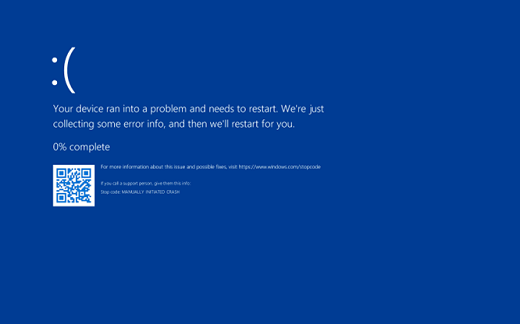Resolving Blue Screen Errors in Windows: An Exhaustive Manual
Introduction
In the realm of computing, facing a Blue Screen of Death (BSOD) can be a harrowing ordeal. This ominous error signifies that Windows has encountered a severe malfunction, necessitating a halt and the display of a blue error screen. Grasping the underlying causes of blue screen errors and their remedies is pivotal for sustaining a robust and stable system.
Deciphering Blue Screen Errors
What Constitutes a Blue Screen Error?
A blue screen error, often referred to as a STOP error, arises when Windows encounters a critical anomaly from which it cannot recover sans rebooting. This can stem from hardware malfunctions, software discord, driver discrepancies, or compromised system files. The blue screen manifests a stop code and occasionally a QR code, conveying insights into the error.
Prevalent Causes of Blue Screen Errors
- Hardware Malfunctions: Faulty hardware elements like RAM, hard drives, or graphics cards can instigate blue screen errors.
- Driver Discrepancies: Outdated or incompatible drivers can engender conflicts culminating in system crashes.
- Software Discord: Conflicting applications or system processes can precipitate blue screen errors.
- Compromised System Files: Damaged or absent system files can disrupt Windows' normal operations.
- Overheating: Excessive thermal conditions can induce hardware failures, resulting in blue screen errors.
Diagnosing Blue Screen Errors
Leveraging the Stop Code
Upon the occurrence of a blue screen error, a stop code is displayed, aiding in pinpointing the precise issue. Recording this stop code is crucial for troubleshooting. Common stop codes encompass:
- 0x0000007E: SYSTEM_THREAD_EXCEPTION_NOT_HANDLED
- 0x00000050: PAGE_FAULT_IN_NONPAGED_AREA
- 0x0000001A: MEMORY_MANAGEMENT
- 0x000000D1: DRIVER_IRQL_NOT_LESS_OR_EQUAL
Employing Windows Diagnostic Tools
Windows offers built-in utilities to assist in diagnosing and resolving blue screen errors:
- Event Viewer: This utility logs detailed data about system events, including blue screen errors. Access it by typing "Event Viewer" in the search bar.
- Windows Memory Diagnostic: This tool examines your computer's memory for errors. Execute it by typing "Windows Memory Diagnostic" in the search bar and selecting "Restart now and check for problems."
- Reliability Monitor: This utility provides a chronological overview of system events and errors. Access it by typing "Reliability Monitor" in the search bar.
Rectifying Blue Screen Errors
Fundamental Troubleshooting Steps
- Restart Your Computer: Occasionally, a simple restart can rectify transient issues causing the blue screen error.
- Check for Updates: Ensure that Windows and all drivers are current. Navigate to Settings > Update & Security > Windows Update.
- Conduct a Virus Scan: Utilize Windows Defender or another reputable antivirus program to scan for malware.
- Liberate Disk Space: Insufficient disk space can lead to system instability. Eliminate unnecessary files and programs to free up space.
Advanced Troubleshooting
Driver Discrepancies
- Update Drivers: Visit the manufacturer's website to download and install the latest drivers for your hardware components.
- Rollback Drivers: If a recent driver update precipitated the issue, revert to the previous version. Navigate to Device Manager, right-click the device, select "Properties," then "Driver," and "Rollback Driver."
- Disable Problematic Drivers: Temporarily disable drivers to ascertain if they are the cause of the blue screen. Navigate to Device Manager, right-click the device, and select "Disable."
Hardware Malfunctions
- Examine RAM: Run the Windows Memory Diagnostic tool to test for memory errors. Replace defective RAM if necessary.
- Test Hard Drive: Utilize tools like CHKDSK to inspect and repair hard drive errors. Open Command Prompt as an administrator and type "chkdsk /f /r" and press Enter.
- Inspect Hardware Connections: Ensure that all hardware components are securely connected.
Software Discord
- Uninstall Problematic Software: If a blue screen error emerged post-installation of new software, uninstall it and observe if the issue persists.
- Perform a Clean Boot: A clean boot initiates Windows with a minimal set of drivers and startup programs. Type "msconfig" in the search bar, select "System Configuration," then "Selective startup," and uncheck "Load startup items."
Compromised System Files
- Run System File Checker (SFC): This tool scans and repairs corrupted system files. Open Command Prompt as an administrator and type "sfc /scannow" and press Enter.
- Utilize DISM Tool: The Deployment Imaging Service and Management Tool can repair Windows images. Open Command Prompt as an administrator and type "DISM /Online /Cleanup-Image /RestoreHealth" and press Enter.
Overheating
- Clean Dust: Dust accumulation can cause overheating. Clean your computer's internals with compressed air.
- Enhance Ventilation: Ensure proper airflow by keeping vents unobstructed and employing cooling pads or additional fans.
Averting Blue Screen Errors
Regular Maintenance
- Keep Windows Updated: Regularly check for and install updates to ensure your system is fortified against known issues.
- Update Drivers: Keep all hardware drivers current to avert compatibility issues.
- Conduct Regular Scans: Employ antivirus and antimalware programs to scan your system regularly.
Prudent Hardware Handling
- Monitor System Temperature: Utilize tools like HWMonitor to track your system's temperature and prevent overheating.
- Handle Hardware Carefully: Avoid physical damage to hardware components by handling them with care.
Backup and Recovery
- Create System Restore Points: Regularly create restore points to revert your system to a previous state if issues arise. Navigate to Control Panel > System and Security > System > System Protection.
- Backup Important Data: Regularly back up your data to prevent loss in case of a critical system failure.
Conclusion
Encountering a blue screen error can be intimidating, but with the proper knowledge and tools, it is manageable. By comprehending the causes, leveraging diagnostic tools, and adhering to troubleshooting steps, you can effectively resolve blue screen errors and sustain a stable Windows system. Regular maintenance and prudent handling of hardware can also help prevent future occurrences

Post a Comment